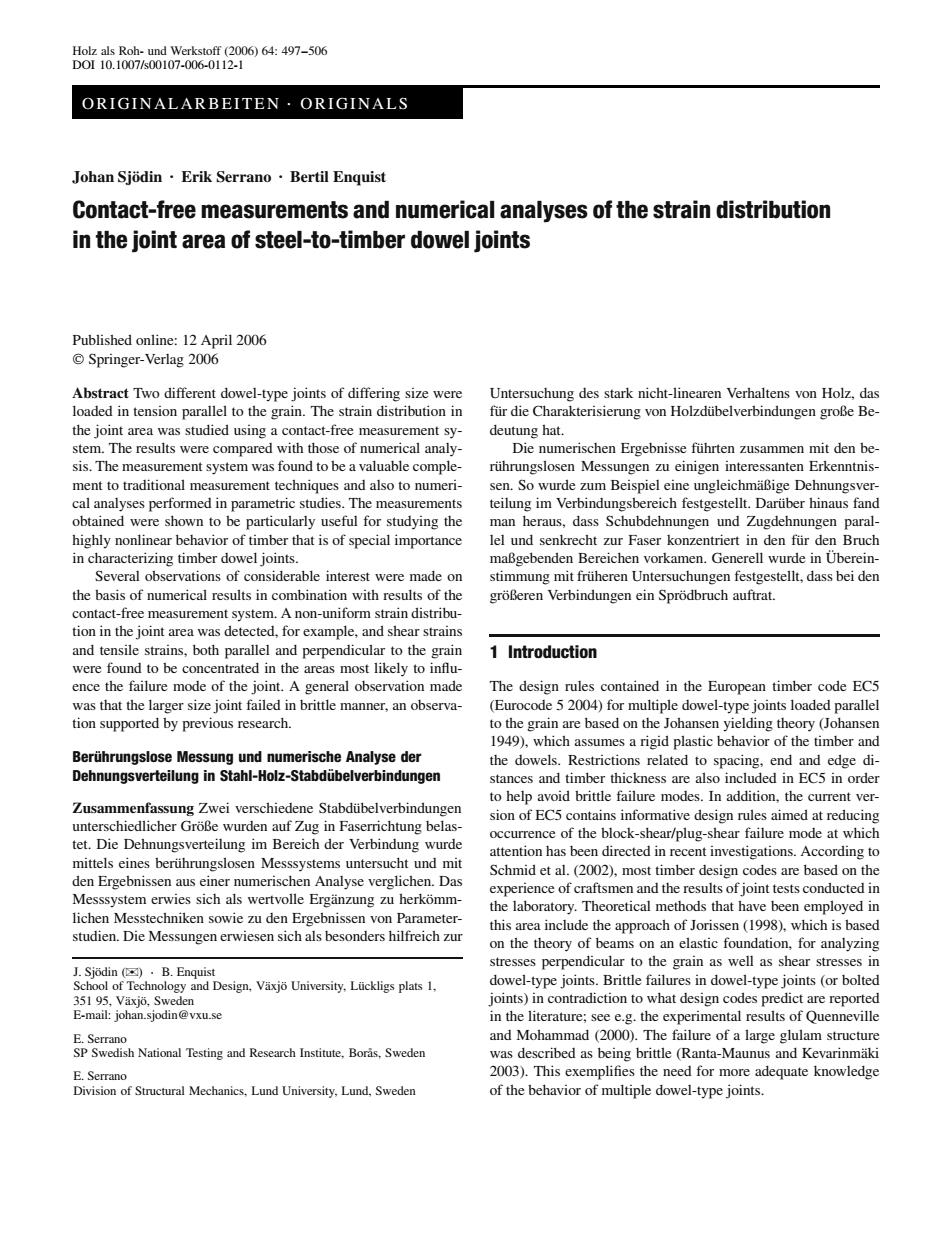正在加载图片...

tio697-0o ORIGINALARBEITEN.ORIGINALS Johan Sjodin·Erik Serrano·Bertil Enquist Contact-free measurements and numerical analyses of the strain distribution in the joint area of steel-to-timber dowel joints the joint area was studied ment s deutung hat. The casuremet sytem a Die numerischen Ergebnisse fuhrten zusammen mit den be- Ito be a le com eilangimVetndnestcrcichfestgecl,Darberhinasfand particularly useful for studying the man heraus,dass S nungen und Zugdehnungen paral tat is of special importance Several observations of considerable interest were made on stimmung mit fruheren Untersuchungen festgestellt.dass bei den the of numerical results in nation with results c groBeren V bindungen ein Sprodbruch auftra tion in the joint area was detected.for example.and shear srains to the grain 1 Introduction ence the failure mode of the ioint. onmade The design rules contained in the european timber code Ecs (Eurocode 52004)for multiple dowel-type joints loaded parallel 99)which ing th y (Joh an lyse der he vels.Restrictions related to spacing.end and edge di es and e m tet.Die Dehnungsverteilung im Bereich der Verbindung wurde untersuch ateengdirectedinrec stigations Messsvstem erwies sich als wertvolle u herkomm rience of craftsmen and the results of joint tests conducted in yed in nissen von Parameter- the laboratory.Theoretical meth 1998, ·B.E tresses perpendicular to the grain as well as shear stre el-type Brittle dowel-type joints(orbol in the literature:see eg the and()The ilure of a large glulam structure Thi tle(R ivctra Mecaics Lund Univriy Lund Sweden of the behavior of multiple dowel-type jonts. DOI 10.1007/s00107-006-0112-1 ORIGINALARBEITEN · ORIGINALS Holz als Roh- und Werkstoff (2006) 64: 497–506 Johan Sjodin · Erik Serrano · Bertil Enquist ¨ Contact-free measurements and numerical analyses of the strain distribution in the joint area of steel-to-timber dowel joints Published online: 12 April 2006 © Springer-Verlag 2006 Abstract Two different dowel-type joints of differing size were loaded in tension parallel to the grain. The strain distribution in the joint area was studied using a contact-free measurement system. The results were compared with those of numerical analysis. The measurement system was found to be a valuable complement to traditional measurement techniques and also to numerical analyses performed in parametric studies. The measurements obtained were shown to be particularly useful for studying the highly nonlinear behavior of timber that is of special importance in characterizing timber dowel joints. Several observations of considerable interest were made on the basis of numerical results in combination with results of the contact-free measurement system. A non-uniform strain distribution in the joint area was detected, for example, and shear strains and tensile strains, both parallel and perpendicular to the grain were found to be concentrated in the areas most likely to influence the failure mode of the joint. A general observation made was that the larger size joint failed in brittle manner, an observation supported by previous research. Beruhrungslose Messung und numerische Analyse der ¨ Dehnungsverteilung in Stahl-Holz-Stabdubelverbindungen ¨ Zusammenfassung Zwei verschiedene Stabdübelverbindungen unterschiedlicher Größe wurden auf Zug in Faserrichtung belastet. Die Dehnungsverteilung im Bereich der Verbindung wurde mittels eines berührungslosen Messsystems untersucht und mit den Ergebnissen aus einer numerischen Analyse verglichen. Das Messsystem erwies sich als wertvolle Ergänzung zu herkömmlichen Messtechniken sowie zu den Ergebnissen von Parameterstudien. Die Messungen erwiesen sich als besonders hilfreich zur J. Sjödin (✉) · B. Enquist School of Technology and Design, Växjö University, Lückligs plats 1, 351 95, Växjö, Sweden E-mail: johan.sjodin@vxu.se E. Serrano SP Swedish National Testing and Research Institute, Borås, Sweden E. Serrano Division of Structural Mechanics, Lund University, Lund, Sweden Untersuchung des stark nicht-linearen Verhaltens von Holz, das für die Charakterisierung von Holzdübelverbindungen große Bedeutung hat. Die numerischen Ergebnisse führten zusammen mit den berührungslosen Messungen zu einigen interessanten Erkenntnissen. So wurde zum Beispiel eine ungleichmäßige Dehnungsverteilung im Verbindungsbereich festgestellt. Darüber hinaus fand man heraus, dass Schubdehnungen und Zugdehnungen parallel und senkrecht zur Faser konzentriert in den für den Bruch maßgebenden Bereichen vorkamen. Generell wurde in Übereinstimmung mit früheren Untersuchungen festgestellt, dass bei den größeren Verbindungen ein Sprödbruch auftrat. 1 Introduction The design rules contained in the European timber code EC5 (Eurocode 5 2004) for multiple dowel-type joints loaded parallel to the grain are based on the Johansen yielding theory (Johansen 1949), which assumes a rigid plastic behavior of the timber and the dowels. Restrictions related to spacing, end and edge distances and timber thickness are also included in EC5 in order to help avoid brittle failure modes. In addition, the current version of EC5 contains informative design rules aimed at reducing occurrence of the block-shear/plug-shear failure mode at which attention has been directed in recent investigations. According to Schmid et al. (2002), most timber design codes are based on the experience of craftsmen and the results of joint tests conducted in the laboratory. Theoretical methods that have been employed in this area include the approach of Jorissen (1998), which is based on the theory of beams on an elastic foundation, for analyzing stresses perpendicular to the grain as well as shear stresses in dowel-type joints. Brittle failures in dowel-type joints (or bolted joints) in contradiction to what design codes predict are reported in the literature; see e.g. the experimental results of Quenneville and Mohammad (2000). The failure of a large glulam structure was described as being brittle (Ranta-Maunus and Kevarinmäki 2003). This exemplifies the need for more adequate knowledge of the behavior of multiple dowel-type joints